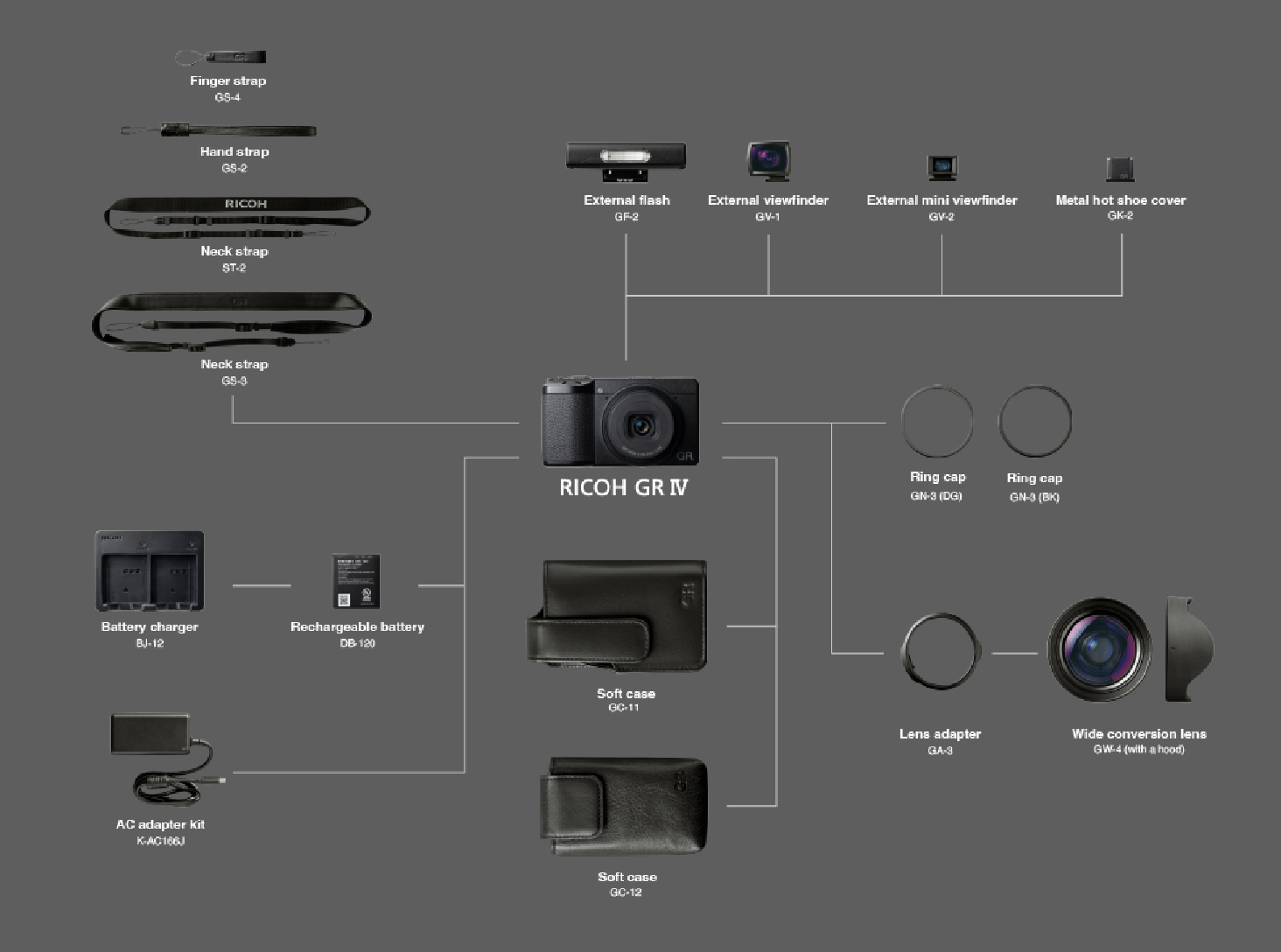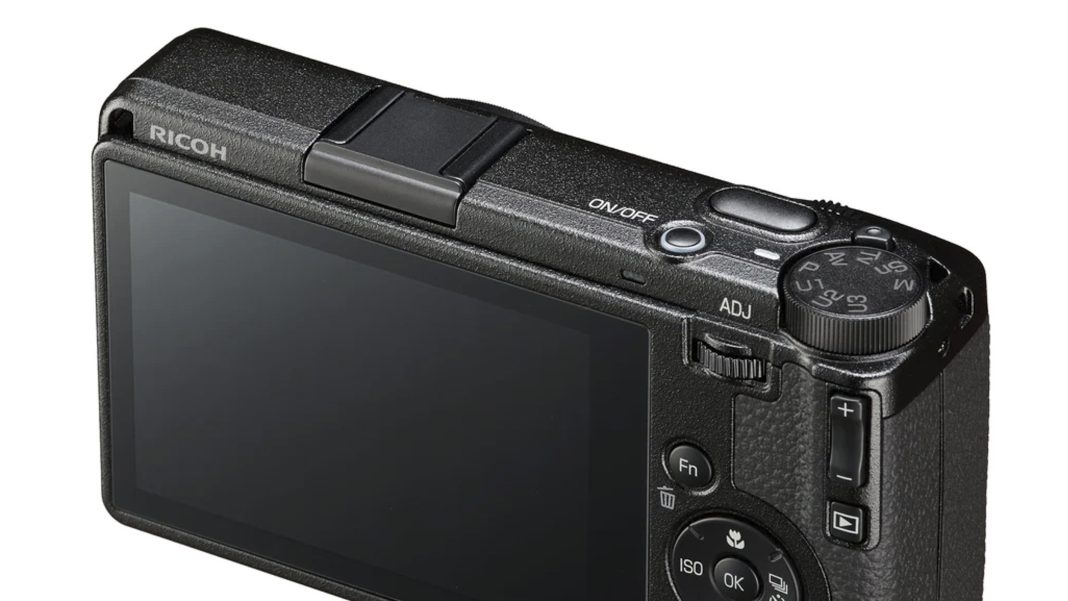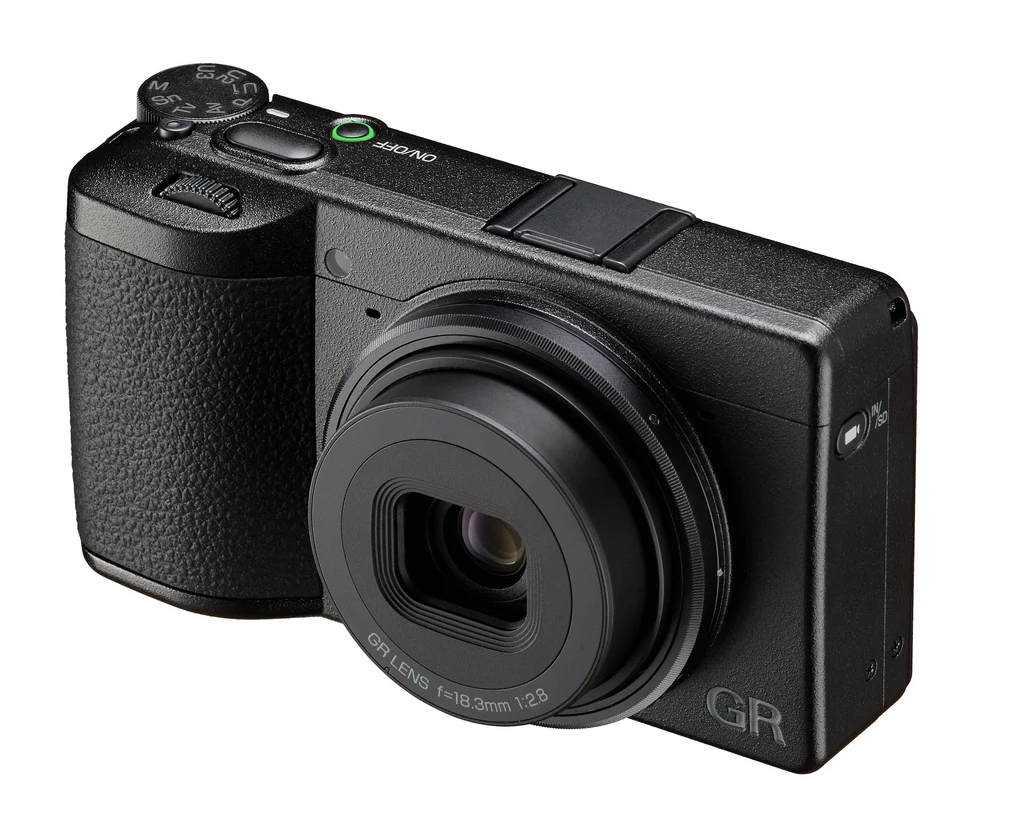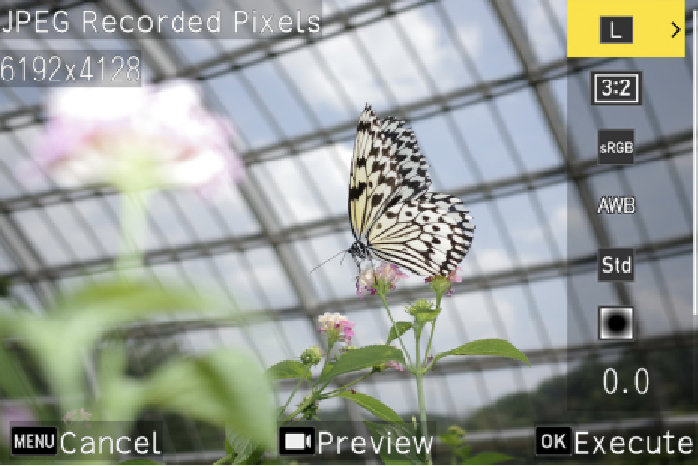It’s here at last. The long-anticipated Ricoh GR IV is announced and will be available from September. While only an expert will notice the difference in appearance, the GR IV has been completely redesigned. It’s slightly smaller overall but comes packed with the latest technology to improve this classic pocket camera which is so highly regarded by professionals and knowledgeable amateurs.
Major upgrades
Three major new upgrades — lens, sensor, and processor — draw a clear line between the IV and previous iterations of the iconic design. The new back-lit 25.7MP APS-C sensor with higher sensitivity and lower noise is only slightly larger than the old 24.2MP unit, but it is claimed to deliver improved image quality.
It incorporates an IR-cut filter with revised antistatic coating to improve the dust-removal operation. Despite the relatively small increase in pixel density, the new sensor helps improve the GR IV’s crop modes, allowing a 15-MP image at 35mm and 7MP at 50mm.
Redesigned
While the Ricoh GR IV’s compact lens retains the same 18.3mm (28mm effective) focal length as the previous unit, it has been completely redesigned to provide higher image quality and snappier performance. It features seven elements in five groups, with glass-moulded aspherical and low-dispersion glass elements for improved sharpness and minimal aberration. The aperture remains f/2.8 in line with previous models.
Also featured is the new Ricoh accelerator unit to optimise signal-to-noise ratio and improvement in image quality at high ISO settings. The native ISO range runs from 100 to an impressive 204,800.
The Ricoh GR IV features an improved SR (shake reduction) mechanism to work alongside the camera’s five-axis IBIS unit, which adds six stops. In comparison, the outgoing model used a three-axis system rated at four stops. In addition, there is a built-in two-stop ND filter.
Faster processor
The newly developed GR ENGINE 7 image processor ensures faster processing, including a remarkable 0.6s fast start-up procedure. The speed improvement extends to swapping to macro mode, faster shut-down and lens retraction, and faster autofocus.
According to the company, the phase-matching hybrid AF system is “significantly quicker, more precise and better in low light”.
Internal storage is a major feature of the Ricoh GR IV, setting it apart from other fixed-lens cameras such as the FujiFilm X100VI, the Leica Q and the Fujifilm GFX100RF. The 53 GB of integral storage is enough for most daily shoots. However, external storage now uses microSD instead of the SD card on the GRIII and predecessors.
The Ricoh GR IV features moderate changes to the functionality, although the basic control concept remains the same. One change, however, is the return of the exposure compensation rocker to the top right-hand edge of the back. It was removed on the GR III because of user complaints that it was too easy to knock with the thumb, but clearly fans of the location for the switch have won the day.
Improved functionality
A new Program Auto Ex function allows users to change exposure mode using either the front or rear command dials. Using the front dial, users can quickly enter Aperture-Priority AE, while the back dial puts the camera into Shutter-Priority AE exposure mode.
The familiar and useful Snap Distance Priority AE mode allows the Ricoh GR IV to tackle zone-focus shooting in a painless, quick and very reliable way.
The redesigned magnesium alloy body measures 109.4×61.1×32.7 mm compared with the dimensions of the GRIII (109.4×61.9×33.2 mm) and it weighs 262g, just 5g heavier than the outgoing model.
The GR IV uses a new DB-120 rechargeable battery, and the company is also providing a dual-battery charger pod as an accessory.
Accessories
The new design will accept the existing lens adapter and wide-angle conversion lens, which changes the angle of view to a useful 21mm. In addition, the new Ricoh GF-2 Super-Compact Flash is also announced today. The 40mm GR IVx and HDF variants are not available at launch but will be introduced in the future.

A new smartphone and tablet application, GR World, will be introduced to enable sharing and customising photographs.
Price and availability
The Ricoh GR IV will be available worldwide in September. The recommended prices are £1,199.99 | $1,499.95 | €1,349.99. UK and German prices include approximately 20 percent Value Added Tax, while the US price is before tax.
Make a donation to help with our running costs
Did you know that Macfilos is run by five photography enthusiasts based in the UK, USA and Europe? We cover all the substantial costs of running the site, and we do not carry advertising because it spoils readers’ enjoyment. Every amount, however small, will be appreciated, and we will write to acknowledge your generosity.







Hopefully a 40mm equivalent comes out soon. 28mm too wide for my liking.
Punchy pricing there, but some worthwhile improvements by the look of it.
If I didn’t already have a GRIIIx HDF and was in the market now, I’d pick up the new one. But I don’t think the improvements are sufficient to justify a switch even if there was a new x version available right now.
On the other hand, as I have been saying to Editor Mike, my little D-Lux 109 is wheezing its way into oblivion with a zoom lens that is mimicking a sloth reluctantly going to work. It may be time for my credit card to take a big leap towards the GRIV…
That would be a worthwhile upgrade for sure.
Ah… you mention the D-Lux, and I am thinking of the D-Lux 8 in particular. Excellent, worthy, versatile, call it what you will, but I am not motivated to use it much. It certainly punches above its sensor size and pixel density — largely because of the optical zoom — but I don’t see it as a main travel camera. The X100VI is more involving, and the GR is just so much more convenient to carry. Answers on a postcard…
As I’ve told you on many occasions, I love the GR III. The only reason I don’t use it as a main travel camera is because I have to use the screen to compose. It isn’t the brightest, and in strong sunlight, I struggle to see what I’m doing. What’s worse, the text displaying exposure parameters is tiny. I find I need glasses, especially in that same sunlight. That, for me, removes much of the joy. However, I love the rest of the camera and I fully understand that the only way to overcome the vision/composing question is to fit an EVF — and that would run against the overall ethos of this camera. Can’t have everything, but it’s worth trying out if you are to make it your main travel camera.
Jon,
I’m in a similar situation, but my Typ 109 has given up the ghost. Oh, once over few months it surprises me by fully extending, but it has gone the way of all flesh.
I liked the manual controls — shutter speed, aperture and an assigned button for ISO. And the EVF. I tried the Panasonic ZS50 and ZS100, but — PASM, it appears, is just not for me. Too many tiny buttons to access important controls. The Sony RX100 series gets great reviews, but suffers from the same buttonology. I’d likely love the Ricohs, but my eyes don’t allow me to use an LCD to focus.
What to do, what to do….
My choice is the X100VI
My 109 broke Charles’ Law in a brain meltdown at a wedding yesterday; not focusing and switching out of RAW+JPG into JPG B&W only. I think it’s time for the retirement draw in the basement.
Strange that Leica 109s are dropping like flies. If I’m not much mistaken, this would be the D-Lux 7, made during the silly season when everything was a Typ(e) instead of a sensible number. Still, this camera was introduced in September 2014 at Photokina — I was there — and it shouldn’t be pegging out so soon. It’s odd that both you and Kathy have similar problems at the same time.
So what are you going to replace it with? I know we’ve discussed this privately, but our esteemed readers might light to chip in. Is it a D-Lux 8, a Ricoh GR IV or, even, a serious foray into APS-C with an X100VI or X-E5? We are all awaiting your decision.
Mike,
The 109 is the D-Lux 6; Jono Slack has a review at his site, and I dimly recall a MACFILOS review — with your name on it, I believe. One consequence of going to the 6 model is that the sensor has only about 12mp useable, compared to the 20-something 7 and 8, so practically any recent camera would be an upgrade of sorts — even the X-Vario!
I do see some X100VI cameras for sale online — some even from reputable dealers! But there is going to be a surcharge 🙁
Ah yes, my mistake, sorry. I did review it. 7 was a typo because I’ve owned both the 7 and the 8 (and the 109/6 for that matter) and know they have the same sensor. However, the usable pixel count on the 7 and 8 is not 20… it’s just under 17. Leica quotes: 4/3“ CMOS sensor, 21,77 MP/17 MP (total/effective). I think it’s actually 16.9 from memory of the comparison tables I did during the cropping exercise last year. I’ve never fully understood why the near-5MP difference between total and effective, but could be something to do with aspect ratios. While the D-Lux 7/8 got plaudits for image quality, there is no doubt that 17MP is now uncompetitive, even in MFT terms where 25MP is becoming the norm. Incidentally, the D-Lux 6 had only 10MP effective, 12 total.
Funnily enough, the improvement that caught my eye was the 53 GB of internal storage. Dare I say it, but the Q3, SL3 have no internal memory — and nor does the much-vaunted Fuji X100VI, or it’s big-brother RF (which at least has two card slots).
I’ve had my GR III since the beginning, so I’ll probably pick up a GR IV and, I suspect, get a good price for the old one.
Concerning pricing, I’ve seen some commentators moaning about “big increase” in cost. But a couple of hundred pounds is not ridiculous these in these days of high inflation and tariff wars.
That’s a good point. The internal 2GB of the GRIII is useful in an emergency but 53GB is properly handy. Does the GRIV let you record an image to internal and micro SD cards, or jpeg to one and RAW to the other?
Not sure about that, Andrew. We don’t get a press pack and I took most of today’s stuff from the website. I suspect they have thought about this.